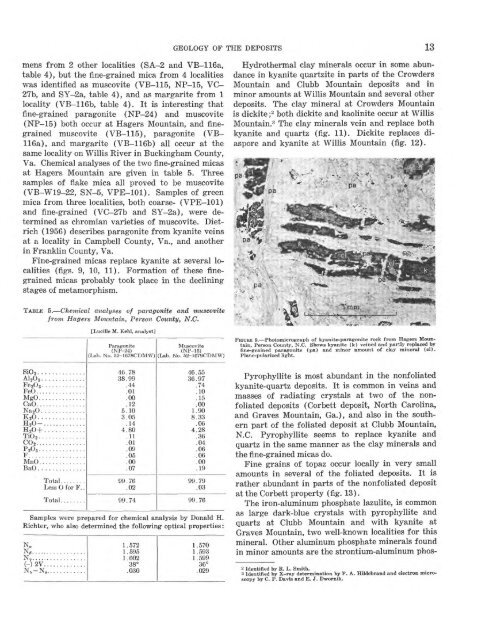Kyanite, Sillimanite, and Andalusite Deposits of the Southeastern ...
Kyanite, Sillimanite, and Andalusite Deposits of the Southeastern ...
Kyanite, Sillimanite, and Andalusite Deposits of the Southeastern ...
Create successful ePaper yourself
Turn your PDF publications into a flip-book with our unique Google optimized e-Paper software.
GEOLOGY OF THE DEPOSITS 13<br />
mens from 2 o<strong>the</strong>r localities (SA-2 <strong>and</strong> VB-116a,<br />
table 4), but <strong>the</strong> fine-grained mica from 4 localities<br />
was identified as muscovite (VB-115, NP-15, VC-<br />
27b, <strong>and</strong> SY-2a, table 4), <strong>and</strong> as margarite from 1<br />
locality (VB-116b, table 4). It is interesting that<br />
fine-grained paragonite (NP-24) <strong>and</strong> muscovite<br />
(NP-15) both occur at Hagers Mountain, <strong>and</strong> finegrained<br />
muscovite (VB-115), paragonite (VB-<br />
116a), <strong>and</strong> margarite (VB-116b) all occur at <strong>the</strong><br />
same locality on Willis River in Buckingham County,<br />
Va. Chemical analyses <strong>of</strong> <strong>the</strong> two fine-grained micas<br />
at Hagers Mountain are given in table 5. Three<br />
samples <strong>of</strong> flake mica all proved to be muscovite<br />
(VB-W19-22, SN-5, VPE-101). Samples <strong>of</strong> green<br />
mica from three localities, both coarse- (VPE-101)<br />
<strong>and</strong> fine-grained (VC-27b <strong>and</strong> SY-2a), were determined<br />
as chromian varieties <strong>of</strong> muscovite. Dietrich<br />
(1956) describes paragonite from kyanite veins<br />
at a locality in Campbell County, Va., <strong>and</strong> ano<strong>the</strong>r<br />
in Franklin County, Va.<br />
Fine-grained micas replace kyanite at several localities<br />
(figs. 9, 10, 11). Formation <strong>of</strong> <strong>the</strong>se finegrained<br />
micas probably took place in <strong>the</strong> declining<br />
stages <strong>of</strong> metamorphism.<br />
Hydro<strong>the</strong>rmal clay minerals occur in some abundance<br />
in kyanite quartzite in parts <strong>of</strong> <strong>the</strong> Crowders<br />
Mountain <strong>and</strong> Clubb Mountain deposits <strong>and</strong> in<br />
minor amounts at Willis Mountain <strong>and</strong> several o<strong>the</strong>r<br />
deposits. The clay mineral at Crowders Mountain<br />
is dickite ;2 both dickite <strong>and</strong> kaolinite occur at Willis<br />
Mountain.3 The clay minerals vein <strong>and</strong> replace both<br />
kyanite <strong>and</strong> quartz (fig. 11). Dickite replaces diaspore<br />
<strong>and</strong> kyanite at Willis Mountain (fig. 12).<br />
TABLE 5. Chemical analyses <strong>of</strong> paragonite <strong>and</strong> muscovite<br />
from Hagers Mountain, Person County, N.C.<br />
SiO 2..............<br />
A1 20 S.............<br />
Fe 20 s.............<br />
FeO........ .......<br />
MgO..............<br />
CaO...............<br />
Na 2O .............<br />
K 20..............<br />
H 20..............<br />
H 20+............<br />
Ti0 2..............<br />
C0t .. .............<br />
P&s ... ...........<br />
F. ................<br />
MnO..............<br />
BaO ..............<br />
Total..... . ..<br />
Less O for F. .<br />
Total..... ...<br />
[Lucille M. Kehl, analyst]<br />
Paragonite<br />
Muscovite<br />
(NP-24)<br />
(NP-15)<br />
(Lab. No. 52-1678CDMW) (Lab. No. 52-1679CDMW)<br />
46.78<br />
38.99<br />
.44<br />
.01<br />
.00<br />
.12<br />
5.10<br />
3.05<br />
.14<br />
4.80<br />
.11<br />
.01<br />
.09<br />
.05<br />
.00<br />
.07<br />
99.76<br />
.02<br />
99.74<br />
46.55<br />
36.97<br />
.74<br />
.10<br />
.15<br />
.00<br />
1.90<br />
8.33<br />
.06<br />
4.28<br />
.36<br />
.04<br />
.06<br />
.06<br />
.00<br />
.19<br />
99.79<br />
.03<br />
99.76<br />
Samples were prepared for chemical analysis by Donald H.<br />
Richter, who also determined <strong>the</strong> following optical properties:<br />
N«<br />
Nfl<br />
N7 . ................<br />
(-)2V.............<br />
N T-N«............<br />
1.572<br />
1.595<br />
1.602<br />
38°<br />
.030<br />
1.570<br />
1.593<br />
1.599<br />
36°<br />
.029<br />
FIGURE 9. Photomicrograph <strong>of</strong> kyanite-paragonite rock from Hagers Mountain,<br />
Person County, N.C. Shows kyanite (k) veined <strong>and</strong> partly replaced by<br />
fine-grained paragonite (pa) <strong>and</strong> minor amount <strong>of</strong>'clay mineral (cl).<br />
Plane-polarized light.<br />
Pyrophyllite is most abundant in <strong>the</strong> nonfoliated<br />
kyanite-quartz deposits. It is common in veins <strong>and</strong><br />
masses <strong>of</strong> radiating crystals at two <strong>of</strong> <strong>the</strong> nonfoliated<br />
deposits (Corbett deposit, North Carolina,<br />
<strong>and</strong> Graves Mountain, Ga.), <strong>and</strong> also in <strong>the</strong> sou<strong>the</strong>rn<br />
part <strong>of</strong> <strong>the</strong> foliated deposit at Clubb Mountain,<br />
N.C. Pyrophyllite seems to replace kyanite <strong>and</strong><br />
quartz in <strong>the</strong> same manner as <strong>the</strong> clay minerals <strong>and</strong><br />
<strong>the</strong> fine-grained micas do.<br />
Fine grains <strong>of</strong> topaz occur locally in very small<br />
amounts in several <strong>of</strong> <strong>the</strong> foliated deposits. It is<br />
ra<strong>the</strong>r abundant in parts <strong>of</strong> <strong>the</strong> nonfoliated deposit<br />
at <strong>the</strong> Corbett property (fig. 13).<br />
The iron-aluminum phosphate lazulite, is common<br />
as large dark-blue crystals with pyrophyllite <strong>and</strong><br />
quartz at Clubb Mountain <strong>and</strong> with kyanite at<br />
Graves Mountain, two well-known localities for this<br />
mineral. O<strong>the</strong>r aluminum phosphate minerals found<br />
in minor amounts are <strong>the</strong> strontium-aluminum phos-<br />
2 Identified by R. L. Smith.<br />
3 Identified by X-ray determination by F. A. Hildebr<strong>and</strong> <strong>and</strong> electron microscopy<br />
by C. P. Da vis <strong>and</strong> E. J. Dwornik.
















